Mar 26, 2016 | coins, education, US Mint, video
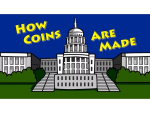 Since the beginning of the year, the U.S. Mint has been issuing a lot of video content primarily videos regarding the launch of America the Beautiful Quarters coins and B-Roll video. This past week, the U.S. Mint issued a new “How Coins Are Made… For Kids!” video as part of their H.I.P. (History In your Pocket) Pocket Change educational program.
Since the beginning of the year, the U.S. Mint has been issuing a lot of video content primarily videos regarding the launch of America the Beautiful Quarters coins and B-Roll video. This past week, the U.S. Mint issued a new “How Coins Are Made… For Kids!” video as part of their H.I.P. (History In your Pocket) Pocket Change educational program.
As opposed to prior videos, rather than have the entire video animated, it uses a combination of animation and the B-Roll video the U.S. Mint published last month. It is done in a way that tells a very coherent story without being cheesy. Everyone will enjoy this video, even if they are just a kid at heart.
If you have an interest in good videos that have been issued by the U.S. Mint you should subscribe to their YouTube Channel. Some of the recent videos that I recommend include an interview with Cassie McFarland, design contest winner for the 2014 National Baseball Hall of Fame Commemorative Coin; B-Roll showing the sculptor-engravers at the Philadelphia Mint; Episode 1 of their “My Favorite” where they interview San Francisco employees about their favorite coins; and “Maryland Quarter in Space” interview with William Krawczewicz, designer of the Maryland State Quarter after Maryland and Florida coins traveled aboard the New Horizons spacecraft.
What is B-Roll
“B-Roll” is a television term for background video that is interspersed within a story. It received its name from the days of editing video segments on film where the primary film that contained the story with the reporter talking was on the “A” or primary roll of film. During the story, there would be other elements cut in with background and other video that was on another reel called the B-Roll. The term has survived through the video and now digital era. Modern B-Roll is now called stock footage.
Feb 12, 2016 | coins, education, history, Royal Mint
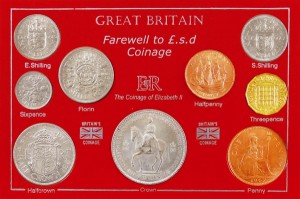
Collection of old pre-decimal coins from during the reign of Queen Elizabeth II.
A very short, simplistic, and incomplete history begins with the Norman conquest of England by William the Conqueror. His invasion of England from Normandy on the northern shores of what is France today in September of 1066 and coronation on December 25, 1066, marks the birth of what would become England.
During the next nearly 50 years, William I (1066-87), William II (1087-1100), and Henry I (1100-35), most of the emphasis has been to finish the conquest and consolidate the ruling under the single crown. The Treaty of Alton (1102) and the subsequent conquest of Normandy (1106) was capable of consolidating power and allowed Henry to attempt to create a sustainable government. Insurgencies from Whales, Rebellion of 1115-20 and the crisis of succession, where is his wife Matilda had not conceived a child, did not allow Henry to finish his work by his death in 1135.
£sd Symbolism
The pound symbol is a fancied “L” based on the Latin librae for weight or balance. It was intended that the 240 pence could be placed on a balance to weigh one pound sterling. The shilling, adapted from the Latin solidus, for solid, was the primary coin of commerce represented with an “s.” For the pence, it used the “d” from the Latin denarius, the smallest Roman coin. Multiple denominations are separated with a slash. For example, 1 shilling can be written as “1/-” while 2 shilling and 3 pence might be written as “2/3d.”
Henry I was succeeded by Stephen, the grandson of William I, with much contention. The problem was that Stephen’s younger brother, Henry of Blois, was embraced by Henry I and subsequently by the Normans. The subsequent civil war lead to a period called “The Anarchy” (1135-1154). During that time Stephen tried to continue with Henry’s reforms but was not able to hold on to the control of the government. Toward the end of his reign, Stephen recognized Henry as the heir to the throne.
With a peace treaty negotiated by Stephen, there was a new peace during the coronation of Henry II in 1154. During the peace, Henry II continued to consolidate power of Norman and Anjou (today this is northern France) and reconstructed the English government.
As part of his reconstruction, Henry II decided to base the currency on the troy pound. The troy pound was based on the Roman libra, which was the basis of weight that England accustomed with. In order to make the money more acceptable, it was divided into 20 units which were originally called testoons. Later, it was renamed as the shilling. As an attempt to make the testoon (shilling) the major unit of currency which corresponded to the Roman solidus. As the solidus was divided into 12 denarii, the testoon was divided further into 12 units with one called a penny and multiples called pence. This was to keep current with the current standard that a pound sterling weight 240 pennyweights.
Early on, it was clear that pence was not small enough of a denomination and was further divided into four parts, two halfpennies or four farthings (quarter pennies). This division was used because the one pennyweight coin representing a penny could not be cut further to represent smaller denominations. Farthings were further divided into smaller denominations using tokes until coins were first used in the 17th century.
To understand this system, I came up with the following table.
| Denomination |
Years struck |
Equivalents |
Relative to a Pound |
Nicknames |
| Quarter farthing |
1839-1853, 1868 |
1/16 d (16 = 1 penny) |
1/3840 pound |
|
| Third farthing |
1827-1913 |
1/12 d (12 = 1 penny) |
1/2880 pound |
|
| Half farthing a |
1828-1856 |
1/8 d (8 = 1 penny) |
1/1920 pound |
|
| Farthing |
1860-1956 |
1/4 d (4 = 1 penny) |
1/960 pound |
|
| Halfpenny |
1672-1860 |
1/2 d (2 = 1 penny) |
1/480 pound |
ha’penny |
| Penny |
1707-1970 |
1d |
240 pence = 1 pound |
|
| Three halfpence |
1834-43, 1860-62 |
11/2 d |
1/160 pound |
|
| Twopence |
1797 |
2d |
1/120 pound |
|
| Threepence b |
1547-1970 |
3d |
1/80 pound |
|
| Groat |
1836-1855, 1888 |
4d |
1/60 pound |
joey, sixpenny bit |
| Sixpence |
1551-1970 |
6d |
1/40 pound |
tanner |
| Shilling |
1503-1970 |
1/- (12 pence) |
1/20 pound |
bob |
| Florin |
1849-1970 |
2/- (24 pence) |
1/10 pound |
two bob bit |
| Half crown |
1707-1970 |
2/6p (26 pence) |
1/8 pound |
|
| Double florin |
1887-1890 |
4/- (52 pence) |
1/5 pound |
|
| Crown |
1707-1965 |
5/- (60 pence) |
1/4 pound |
|
| Sovereign (pound) c |
1817-1917, 1925, 1957- |
240 pence |
10 Shillings |
|
| Half guinea |
1699-1816 |
10/6d |
1/8 ounce of gold |
|
| Guinea d |
1663-1814 |
21/- |
1/4 ounce of gold |
|
Notes:
- Half farthing was originally made for Ceylon
- Three halfpence produced for circulation in the British colonies, mainly in Ceylon and the West Indies
- A one pound coin made of gold was called a Sovereign
- The guinea came into English after the Guinea region of West Africa was discovered by the British and mined its gold
- Not listed is “quid,” the nickname of a one-pound paper note
This was the system until Decimalization Day on February 15, 1971.
Today, British coins are divided into 100 pence to one pound. The coins struck for circulation by the Royal Mint are 1 Penny, 2 Pence, 5 Pence, 10 Pence, 20 Pence, 50 Pence or Half-Pound, £1 (pound), and £2. Paper currency is issued for denominations of £5 and greater.

United Kingdom modern decimalization redesign of 2014 resembles a shield.
Credits
- Image of pre-decimalization coins courtesy of Coincraft
- Image of 2014 United Kingdom shield set courtesy of the Royal Mint
Feb 6, 2016 | administrative, coins, education
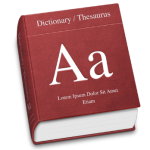 Since having the Numismatic Dictionary active for over a month, the reception has been more than my expectations!
Since having the Numismatic Dictionary active for over a month, the reception has been more than my expectations!
According to the server statistics, there have been over 500 unique visitors to that page with more 20-percent returning for another look. Since I put a bit of work into that database, it is nice to see it is being used.
I also received feedback with corrections and requests for additions. Corrections are wonderful and encouraged. If you see something wrong, send me a note and I will make the correction.
As for the additions, I received a request for 12 additional terms. As I was researching some of the terms to ensure I entered the right information, I found a few more to add. I had to stop at adding 51 additional terms. Some of the new additions include banknote, bit, branch mint, coin orientation, crown, encased postage stamps, euro, farthing, intaglio, legal tender, manganese, medal orientation, pet crime, pound, real, shilling, small dollar, and third-party grading service.
I really appreciate all of the input and hope it helps the numismatic community!
Feb 3, 2016 | administrative, coins, education, US Mint
 Recently, I was notified that the company whose notebook-like program decided to close its virtual doors. Its concept was simple: act like a notebook that you can stuff anything into. Although other programs passed it in some features, it was still a solid way of keeping a digital notebook. Now that they are out of business, I do not want to rely on what we call “abandonware.”
Recently, I was notified that the company whose notebook-like program decided to close its virtual doors. Its concept was simple: act like a notebook that you can stuff anything into. Although other programs passed it in some features, it was still a solid way of keeping a digital notebook. Now that they are out of business, I do not want to rely on what we call “abandonware.”
As I was reviewing a few of the notebooks I created, I found now with a lot of numismatic notes. This notebook contains lists, ideas, and other items of numismatic information. Rather than keep them hidden from the public on my disk, I will start to publish what I find as part of my Collector’s Reference section.
Today begins with two additions:
- Key Date Coins is a list of coins that may be considered key dates for their series. Determining key date coins sometimes is a matter of opinion, especially on older series. My notes had several lists which I used a basic polling system, mintage statistics, and third-party grading company’s population reports to determine what to add. This list only does this for non-gold coins. I will try to find similar references for gold coins and add them in the future.
- Mints and Mintmarks documents every branch mint operated by the U.S. Mint and provides a little information paragraph about them including the branch mint in Manila while the Philippines was a colony of the United States.
I hope you find this helpful. As always, you can always send me additions or corrections. Other comments are welcome below.
Jan 28, 2016 | celebration, coins, dollar, education, history, US Mint
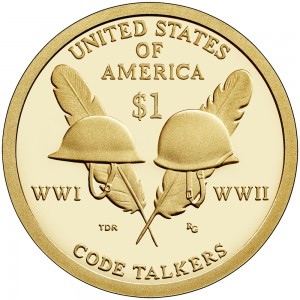
2016 Native American Dollar celebrates the contributions of the Native American Code Talkers in World War I and World War II
The reverse designs has represented some of the best work by the artists working with the U.S. Mint with the 2016 design continuing the record. Celebrating the Native American Code Talkers who were instrumental in using their native language to communicate troop movements and enemy positions, the reverse of the coin celebrates their work.
As someone who has made a career in technology and information security, the concept of using something as low-tech as a language that nobody else can translate to openly communicate secret information is an elegant solution. It proves that technology is an answer but not the only answer. It makes these people heroes for their service to a country that has not treated their people fairly over the course of history.
Learning and honoring the history of Native Americans was the goal of the Native American $1 Coin Act. It is a simple yet effective way to bring history to the masses. Although the dollar coin does not circulate well, it is still a nice way for the country to teach and honor history.
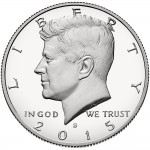
I don’t think JFK would mind using the reverse to honor U.S. history!
As I consider writing a draft version of the bill to send to my representatives in congress, I know that any good coinage program in the United States should have some guidelines. Far be it for congress to tell the U.S. Mint to do what it thinks is right. In order to satisfy something that congress would adopt and create a meaningful program, how about a Half-Dollar history program as follows:
- The obverse will remain unchanged, the edge will continue to be reeded, and the coin will remain a half-dollar
- Reverse design changes annually and only one design per year
- Half-dollar can be made for circulation and the U.S. Mint can create collector versions including silver collectibles and different finishes
- Theme for the reverse must be from 50 years prior to the year of circulation and older with anniversary dates being divisible by 25 (i.e., 50 years ago, 75, 100, 125, 150, etc.)
- Theme will be selected by the U.S. Mint in collaboration with the CCAC and the Smithsonian Institute National Museum of American History
- The U.S. Mint creates the design for the theme selected by either using in-house artists, AIP members, or may hold an open competition
- The CCAC will review the designs
- The program will have no end date
Although there was no such thing as having a minor when I went to college, I did use some of my elective credits to take some classes in history and political science. Add my masters in public policy and some people wonder why I don’t run for office (I hate the idea of begging for campaign contributions). With that background, I was able to think of a few historical events that could be honored over the next few years:
2017: The 150th anniversary since the U.S. purchased the Alaska territory from Alexander II of Russia by Secretary of State William H. Seward in 1867. This was so unpopular at the time it was called “Seward’s Folly.”
2018: World War I ended on the 11th hour of the 11th day of the 11th month of 1918.
2019: “What hath God wrought” was the message of the first telegram message. It was sent from the U.S. Capitol to the B&O Railroad depot in Baltimore 175 years ago.
2020: The 100th anniversary of the passage of the 19th Amendment granting suffrage for women
2021: The 50th anniversary of the passage of the 29th Amendment that lowered the voting age to 18.
2022: Celebrating 75 years of technical innovation. In 1947, Dr. Edwin Land introduced the Polaroid Land Camera, broadcast of the first World Series game, the USS Newport became the first warship that was fully air conditioned, Chuck Yeager breaks the sound barrier, and Bell Labs scientists introduces the first semiconductor are just some of the innovations to celebrate.
Purposely missing from this list is the 75th anniversary of Jackie Robinson’s becoming the first African-American to appear in a Major League Baseball game in 1947. I fully expect that a commemorative coin will be issued for that event. If it is not, then congress should be ashamed of itself for not doing so.
Coin images courtesy of the U.S. Mint.
Jan 24, 2016 | BEP, cash, coins, currency, education, US Mint

Marriner S. Eccles Building where the Federal Reserve Board is located
The process begins when the Federal Reserve places their annual order with the U.S. Mint for coins and the Bureau of Engraving and Printing for currency. Like any organization that deals with inventory, the Federal Reserve will estimate its order based on a projection of demand.
Inventory management for the Federal Reserve requires them to know how much currency is in circulation, how much will be required based on world-wide economic factors, and what would be required to replace the current currency supply. Since the Federal Reserve ships U.S. currency world wide, especially the $100 Federal Reserve Notes, someone has to project what the world is going to demand based on economic factors that it has no participation in.
Life Expectancy of U.S. Currency
| Denomination of Bill |
Life Expectancy (Years) |
| $ 1 |
5.9 |
| $ 5 |
4.9 |
| $10 |
4.2 |
| $20 |
7.7 |
| $50 |
3.7 |
| $100 |
15 |
Not only does the Federal Reserve has to track the amount of money in circulation but they also have to account for the different denominations in order to replace torn and worn notes. For instance, it was once estimated that 90-percent of the order for $1 Federal Reserve Notes were delivered to replace worn notes in circulation.
Once the order is placed by the Federal Reserve, the U.S. Mint and the Bureau of Engraving and Printing work to fulfill that order. The U.S. Mint strikes the coins and has they placed in one-ton ballistic bags for delivery. The Bureau of Engraving and Printing bundles the currency in packs. Multiple packs make a brick. Bricks are then piled on pallets that are used for delivery.
From Philadelphia and Denver, the coin bags are loaded onto secured trucks and transferred to the Federal Reserve for distribution. A similar transfer happens at the Bureau of Engraving and Printing in Washington and Fort Worth where the pallets are shipped to the Federal Reserve.
Although there may be a few warehouses and other distribution processes involved, the coins and currency are shipped to one of 26 “cash rooms” around the country based on need. These cash rooms are special warehouses operated by the Federal Reserve branch that store the physical currency before being distributed to the member banks.

Federal Reserve Bank of New York
Before currency can enter circulation, a member bank places an order with the Federal Reserve. It is then delivered to them from the closest cash room with the appropriate inventory necessary to fulfill the order.
Your personal bank is like the corner store in the ordering system. When the shelves are bare or threatening to go bare, they order the inventory of currency they need. The corner bank just do not order money from the Federal Reserve. Banking companies work on behalf of their branches to manage inventory. The big bank may have their own cash management operations that help ensure that they not only have the appropriate amount of currency available but they do not have too much in storage. Like product inventories, idle money is not good for business.
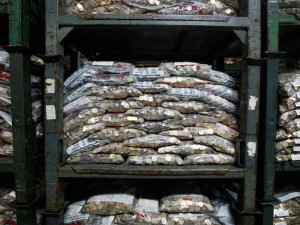
Federal Reserve Bank of Richmond Baltimore Coin Storage

Federal Reserve Bank of Atlanta Cash Operations
Many banks hire logistics companies to help with the flow of their currency inventory. These companies are the ones driving the armored trucks you see around town that delivers currency on order. While these logistic companies are registered currency distribution services and have permits to pick up inventory from the Federal Reserve cash rooms on behalf of the member banks, they also provide storage and delivery services.
Although your corner bank has a vault, each banking company limits the amount of currency they keep on site because of security concerns. When they need additional currency or have an excess that needs to be stored, they call the logistics company to physically move the inventory.

Four of the largest cash logistics companies
Depending on how fast the currency is needed to circulate by your corner bank, existing currency can circulate through the logistics processing center long before the new inventory is placed into circulation.
During the recent downturn in the economy, the banks’ inventories of coins increased as people emptied jars, jugs, and bottles of coins for necessities. As the coins were returned to the bank the inventories rose beyond what they needed for circulation reducing the requirement for the banks to order more coins from the Federal Reserve. This is why it was not surprising that many people did not see current year coins until as early as April.
It is more difficult to gauge when currency reaches circulation unless there is a change in the series designation. The Series of a note is the date followed by a letter indicating that there is a change, usually to the autograph of the Treasurer or the Secretary of the Treasury. Although there is no rule, the Series date changes with an administration and the letter is added and changes as the autographs changes. Sometimes, the series date changes with the design of the currency. These are recent conventions and not the rule. All printing and design decisions are made by the Federal Reserve, Bureau of Engraving and Printing, and the U.S. Secret Service as a team.
If you want to know when the 2016 coins will reach circulation, the answer is “I don’t know.” Considering the economy is in better shape than in years past, money continues to circulate, and the U.S. Mint has produced more coins in a single year than any other in its history, if you have not seen a 2016 coin in your pocket change soon, then my best guess will be in mid-February—if the weather holds up!
Credits
- Eccles Building image courtesy of the Federal Reserve.
- Federal Reserve Bank of New York building courtesy of the Federal Reserve Bank of New York.
- Image of the Federal Reserve Bank Baltimore Coin Room courtesy of NPR.
- Image of the Atlanta Federal Reserve Bank Cash Operations courtesy of Glassdoor.com.
- Armored vehicle image courtesy of Prinéa.
Oct 23, 2014 | coins, commentary, education, medals, tokens
Advancements in all areas of life, whether it is the cars we drive, the entertainment that we like, how we shop, and where we get our news are inevitable. Where the car I drove in college had a the classic Chrysler Slant 6 engine with nothing electronic, I now drive a Chevy pickup with a Vortec V8 with variable timing controlled by a computer that will even start with the push of a button on my key fob.
Rather than complain about these changes, I try to embrace them as progress. After all, I started programming computers by punching cards in the 1970s. Today, the smartphone in my pocket has more computing power than anyone could have imagined while feeding our cards through the reader waiting for output on green bar paper.
Because I like to be progressive with technology and feel that not only have I seen a lot but that I adjusted, I tend to look down on those who cannot. I know that it may be elitist and contemptuous on my part and I should be more understanding, especially now that I bought a car with a Slant 6 as a toy and want another car without all of the electronics.
This self examination was prompted by an article by Q. David Bowers that appeared online on the Coin World website. In the article, Bowers reflects back as to how the hobby has changed since he started writing his column in 1961 and what it is today.
Basically, you used to have to know more about numismatics. You had to know what you were looking at in order to grade coins, know where to find the prices, have the education to know what is fake and what is not, and have a trusted dealer that you can go to to help you with your collection. It was a lot like my Slant 6 in that while the dealer would help, I had to know more about the car in order to keep it running, especially as a poor college student.
Today, Bowers says it succinctly, “No knowledge is necessary!”
While this can help grow the hobby, it makes it just a bit colder. You do not need a dealer when the Internet will do. You do not need the knowledge when companies will entomb a coin in plastic, say it is genuine, and assign a grade so you know what its state of preservation is. If the plastic is not enough, you can even find someone to place a sticker on the plastic to bless that the plastic is good. Then the sticker placer will buy the plastic to churn the market that will essentially drive up the prices.
Although the grading services do provide a service that guarantees the coin’s authenticity, they have also created a fervor over plastic that caused the the despicable behavior during the launch of the Kennedy gold tribute coin.
“If you are typical, quality means nothing. The label on a holder takes care of everything,” writes Bowers. Sadly, he is right because people are no longer collecting coins. They are collecting plastic and stickers while watching online price guides the way day traders watch stock prices. If the coin does not raise in value fast enough, they will buy the next number higher on a plastic package even if the new coins does not look better than the old coin.
Just like listening to the whine of a hybrid takes the charm out of being a car enthusiast, plastic and stickers are taking the charm out of collecting.
To regain the charm Bowers suggests niche or specialty collecting. He says to, “Check out the websites of the Colonial Coin Collectors Club, Early American Coppers, the Liberty Seated Collectors Club and the Numismatic Bibliomania Society, and poke around!”
In addition to Bowers’ suggestions, you may also want to consider Token and Medals Society along with the regional chapters, The Elongated Collectors (TEC), and even the American Vecturist Association. What makes tokens, medals, and even elongated coins very interesting is that you can really personalize a collection. Think about it, how many places have you visited that had a machine where you drop in some money plus a “lowly” Lincoln cent and with a turn of a crank you have the equivalent of a numismatic post card!
A hobby should be fun. So forget the plastic and stickers and go find something and have some fun.
For a little fun, here is a sample of my “Hometown Collection.”
-

-
1984 LIRR Sesquicentennial Bronze Medal
-

-
TBTA Toll Token
-
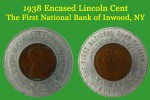
-
1938 Encased Cent from the First National Bank of Inwood (NY)
-

-
A check from the First National Bank of Inwood (NY)
-

-
Medal from the opening of the Brooklyn Bridge in 1883
-

-
1956-D Encased Cent from the Chase Money Museum
-
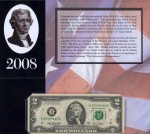
-
2008 $2 Single Note from the New York Fed
May 27, 2014 | BEP, currency, dollar, education, news, video
Time has come that there is once again change coming to the money in your pocket. This one is so subtle that you may not even notice the difference.
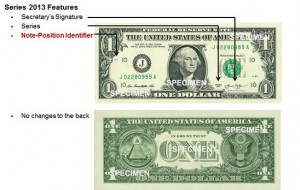
Changes to the $1 Note
For those who do not collect currency, the note-position identifier is the little letter followed by a number that identifies where on the sheet the note was printed. On the $1 FRN, the note position identifier is on the left side of the front of the note under the “1” and next to the Federal Reserve branch number.

Change in the Note Position Identifier
As part of this change, the BEP is also changing the position identifier code mechanism. On the 32 note sheets, the notes printed four-across and eight-down were divided into four eight-note blocks (or quadrants). Each block was given a number in columns where the top-left quadrant was #1, the bottom left was #2, top-right was #3, and bottom-right was #4. Within the quadrants, the note positions were lettered A-D in the first column and E-H in the second column. If you found a note with the note-position code of H3, the note would have been printed in the fourth row and fourth column of the sheet.
The new 50 note sheets simplifies the note-position numbering by assigning a letter to each of the 10 rows (A-J) and a number to each of the five columns. On this sheet, H3 would now be located on the eighth row and third column.
Position Identification layout of 32-note sheet
| A1 |
E1 |
A3 |
E3 |
| B1 |
F1 |
B3 |
F3 |
| C1 |
G1 |
C3 |
G3 |
| D1 |
H1 |
D3 |
H3 |
| A2 |
E2 |
A4 |
E4 |
| B2 |
F2 |
B4 |
F4 |
| C2 |
G2 |
C4 |
G4 |
| D2 |
H2 |
D4 |
H4 |
Position Identification layout of 50-note sheet
| A1 |
A2 |
A3 |
A4 |
A5 |
| B1 |
B2 |
B3 |
B4 |
B5 |
| C1 |
C2 |
C3 |
C4 |
C5 |
| D1 |
D2 |
D3 |
D4 |
D5 |
| E1 |
E2 |
E3 |
E4 |
E5 |
| F1 |
F2 |
F3 |
F4 |
F5 |
| G1 |
G2 |
G3 |
G4 |
G5 |
| H1 |
H2 |
H3 |
H4 |
H5 |
| I1 |
I2 |
I3 |
I4 |
I5 |
| J1 |
J2 |
J3 |
J4 |
J5 |
BEP has begun to deliver the new notes to the Federal Reserve currency distribution operations in all 12 Federal Reserve district branches. These new notes will enter circulation as per the policies of each branch. BEP has not said whether they will sell the 50-note sheets as part of their uncut currency products.
The $1 FRN is the first note to be printed on 50-note sheets. Over time, the BEP will transition the printing of other notes to 50-note sheets with the only design change being the subtle change in the note-position identifier.
As part of this change, the Federal Reserve created a video explaining the changes. You can watch the video here:
Images courtesy of the Bureau of Engraving and Printing.
Apr 26, 2014 | advice, education, security, technology, web
 The Royal Canadian Numismatic Association sent email to its members notifying them that on April 24 someone attempted a phishing scam trying to impersonate the RCNA Executive Secretary trolling for information. The RCNA did not send out an email note asking for information and recommended deleting them email.
The Royal Canadian Numismatic Association sent email to its members notifying them that on April 24 someone attempted a phishing scam trying to impersonate the RCNA Executive Secretary trolling for information. The RCNA did not send out an email note asking for information and recommended deleting them email.
Phishing is the term used to describe the attempt to convince someone to reveal personal information by sending them an email that looks like it came from a legitimate source. In this case, the attacker made their email look like it came from the RCNA hoping that members would give up their personal information.
When I am not blogging, meeting with other numismatists, or being with my family, I work in information security for the United States federal government. In my professional life, I have seen a lot of attempted and successful attacks against both government and commercial systems. However, the one attack that is the most difficult to defend are those where humans are convinced to act against their own best interest, such as a phishing attack.
Social engineering attacks are my favorite attacks. One reason is that it helps demonstrate to the organizations that I try to help that security is more than controls, encrypted communications, or anything else you might have read in the news. Security is a process that requires diligence, the same as it does in the real world.
The following are four rules that you can follow to help keep safe online:
Rule #1: Unless you are 100-percent certain that the email is legitimate, do not click on the link!
You will be never 100-percent certain that any email you receive is legitimate so make sure that you are as close as 100-percent certain as possible. One thing you can do is to move your pointer over the link, stop, and wait for the tooltip to show you the address.
Tooltips are those balloon-like popups that will tell you something about the link or element before you press the mouse button. One way to tell that a link is bad is that if the address is not what you think. For example, if the link is supposed to send you to the RCNA website, the tooltip better say that it will send you to rcna.ca. If it does not, then do not click on the link.
When you check the link, the address of the server is the first part of the address. If what should be the server name is not in that area at the beginning of the address, do not click on the link.
One trick the phishers use is to show you what looks like a complicated address in the message, but the link behind it will send you to another website. This is where tooltips can help. If you hover over the address and they do not match, it is an attempt to trick you and you should not click on the link.
If you are using a web-based email client, you can check the address on the status line at the bottom of your browser window. Check to see if the address makes sense is also a good tool. For example, if the link is supposed to be from the RCNA and “rcna.ca” is not the address of the server in the link, then it is a phishing attempt and you should not click on the link.
If you are unsure about the link, then go to your browser and type in the address yourself. Rather than clicking on a suspicious link, you can visit the RCNA website by typing “http://rcna.ca” directly into your browser’s address bar.

Anatomy of a Phishing email
(courtesy of the University of California-Davis)
Rule #2: No legitimate company or organization will send you a form to fill out and email back
One of the tactics that the phishers use to try to trick you into giving them your personal information is to create a form that looks like it is legitimate. Just as it is easy for someone with moderate skills to fake a web page, they can create a counterfeit form. Not only will the form be counterfeit, but they could also embed programs in that form to steal your information.
Embedded code in documents is called macros. Macros are used to command programs to do something for the user. When used in productive environment, macros can be a wonderful tool to create dynamic documents. But the same instructions that can make macros a productive tool can also be used to do bad things.
Unless you are certain about where the document came from, then do not open a document. If you open the document and the program asks if you should enable or run macros, do not enable macros.
This is not just a problem with word processing document. PDF documents can also deliver very nasty malware (malicious software). Not only can an attacker add macros to a PDF document, but someone can embed the technology called Flash in those PDF. Flash is the technology that helps you see videos and add enhancements to the visual interface of some websites. But Flash can be used to attack your computer system. Opening a PDF file sent by someone you do not know can be as dangerous as a word processing document.
Rule #3: Do not open suspicious attachments
Another trick the attackers try to use is adding an attachment named in a way to try to trick you into opening the file. File names consist of the name of a file followed by a period followed by a file extension. The file extension is used to tell the computer the type of program to open to allow you to work with the file. There are three file extension that very dangerous and should never be opened unless you are absolutely sure who sent them to you: .zip, .exe, and .dmg for Mac users.
The .zip file extension tells the computer that the file is something called a Zip archive. A Zip archive is a file that is formatted to allow it to store many files that are compressed. Zip files are used for many legitimate purposes including being the default format of Microsoft Word’s .docx file. Unfortunately, it can contain files that can be used to attack your system.
One of the types of file that can be included in a Zip archive is an .exe or executable file. Simply, these are programs in the same way that Microsoft Word is a program. Once an executable file is opened, it will do whatever it is programmed to do. Among the things that the program can do is key logging. A key logger reads what you type on your keyboard, what you click on the screen, and in some cases what is displayed on your screen. The key logger will be able to capture the user name and password you entered when you visit any website including your bank’s website. The problem is that when a key logging program is run, you do not know it is watching what you type. Nor do you know that it connects to a server somewhere on the Internet to send the information to the attacker.
While Macs are more difficult to attack, they are not immune. Mac users should never open a file with a .dmg file extension unless you know who sent the file. The Macintosh .dmg file is a disk image file. A disk image file is formatted to look and acts like a disk so that when you double click the file, it will mount on your computer as if you plugged in an external disk drive. Because .dmg files are commonly used to install legitimate software, sometimes the installation can be automatically started. If you allow the installation to continue, it you can install software as dangerous as what I described for the Windows .exe file.
Rule #4: When in doubt, throw it out!
 While all this seems simple to me, I have been in this industry for over 30 years and am used to the complication. The problem with email is that it was developed as a way for researched to communicate by plain text across the Arpanet, the forerunner of the Internet. Essentially, email is a text-based service that has been extended in so many ways that it has created a complicated series of standards that requires a degree in computer science to analyze.
While all this seems simple to me, I have been in this industry for over 30 years and am used to the complication. The problem with email is that it was developed as a way for researched to communicate by plain text across the Arpanet, the forerunner of the Internet. Essentially, email is a text-based service that has been extended in so many ways that it has created a complicated series of standards that requires a degree in computer science to analyze.
Even if you cannot fully analyze whether the message is spam or legitimate, if you have any doubt, then just press the delete button. If the message came from a source you know, contact them off line and ask if the mail is legitimate. If you think the email is from your bank, call the bank and ask. If you think the email is from your credit card company but not sure, call the credit card provider and ask. If you think the email sent from the RCNA is suspicious, call them and make and ask.
A little intuition can be of great help in these circumstances.
Stay safe online and have a good weekend!
Sep 1, 2013 | ANA, books, charity, coins, education, personal, review
 Last year I reviewed The Official 2013 Blackbook Price Guide to United States Coins I received as an e-book from the publisher. In that review I was surprised as to the quality information that was in the book including articles that were written by numismatists sharing their expertise with the collecting public. Unfortunately, some of the information seemed dated and needed updating. Apparently the editors agreed and worked to update information.
Last year I reviewed The Official 2013 Blackbook Price Guide to United States Coins I received as an e-book from the publisher. In that review I was surprised as to the quality information that was in the book including articles that were written by numismatists sharing their expertise with the collecting public. Unfortunately, some of the information seemed dated and needed updating. Apparently the editors agreed and worked to update information.
Based on the review, the editors turned to a numismatist whose experience with computers, the Internet, and writing for the collector who could add the information about using technology to enhance the collecting experience.
This is where your favorite blogger enters the picture.
The Official 2014 Blackbook Price Guide to United States Coins has an new chapter, “Using Technology to Enhance Your Collecting Experience.” Written in plain language for the collector, the chapter discusses what numismatic-related resources are online.
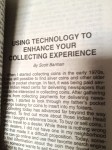 The chapter opens with a brief history of how computers and the Internet has advanced my collecting experiences. This includes a brief history of the Internet from its birth as ARPAnet through the invention of the birth of the World Wide Web and the services we now take for granted. I wrote it so that when you hear something Internet and web history in the news you have the background to understand why it is important.
The chapter opens with a brief history of how computers and the Internet has advanced my collecting experiences. This includes a brief history of the Internet from its birth as ARPAnet through the invention of the birth of the World Wide Web and the services we now take for granted. I wrote it so that when you hear something Internet and web history in the news you have the background to understand why it is important.
Following the introduction are sections that helps you find the information you want online. These sections are titled:
- Online Price Guides
- News and Blogs
- Mobile Computing
- E-books
- Social Media
- Buying and Selling Online
- Auctions (Established auction houses and their online options)
- Looking into the Future
- Your Security Online
If nothing else, the section “Your Security Online” may be worth the price of the book. It is something I have written in many forms, in many places, and have lectured about locally. These are general awareness tips that everyone should follow.
To their credit, the editors Mark Hudgeons, Tom Hudgeons Jr., and Tom Hudgeons Sr. read my review and updated the 52nd Edition of The Blackbook to address many of my concerns outside of my chapter. It is a better reference than in the past and worthy of a place in your numismatic library!
Autographs For Education
After autographing my first copy of the book I decided that rather than give away my autograph I want to use it to help raise money for numismatic education. For every autograph, I am asking for a minimum donation of $25 to the American Numismatic Association Florence Schook School of Numismatics to be used to further all numismatic education.
You can either mail the check yourself to the ANA and show me that you donated or give me the check and I will mail all of them together. Checks given to me should be made payable to the “American Numismatic Association” (NOT ME!) with a note on the memo line saying “For The Florence Schook School of Numismatics.”
For your donation, I will autograph the first page of my article above the title and give you recognition here on the blog. Since the ANA is a not-for-profit organization, your donations are tax deductible to maximum allowed by law.
One way to find out where I will be is to follow me here on the blog since I usually announce when I am going to a show. For planning purposes, I will attend the Virginia Numismatic Association Show on Saturday, September 28; the Pennsylvania Association of Numismatists show during October 24-26 (my attendance dates TBD) in Monroeville (a suburb of Pittsburgh); and the Whitman Baltimore Expo on Saturday, November 9. I might attend the Wall Street Coin, Currency and Collectibles Show in October if I can resolve a scheduling conflict.
Of course scheduling conflicts do arise, but let me know you if you will be looking for me at a show.
Post Script
Collectors of paper money, world coins, and stamps will be happy to know that the chapter will be adopted for the Blackbook covering those areas in 2015. I will also update the the current chapter since the online world has changed a little since it was written (e.g., Google shutdown the Reader service).
Book cover image courtesy of Random House.
 Since the beginning of the year, the U.S. Mint has been issuing a lot of video content primarily videos regarding the launch of America the Beautiful Quarters coins and B-Roll video. This past week, the U.S. Mint issued a new “How Coins Are Made… For Kids!” video as part of their H.I.P. (History In your Pocket) Pocket Change educational program.
Since the beginning of the year, the U.S. Mint has been issuing a lot of video content primarily videos regarding the launch of America the Beautiful Quarters coins and B-Roll video. This past week, the U.S. Mint issued a new “How Coins Are Made… For Kids!” video as part of their H.I.P. (History In your Pocket) Pocket Change educational program.

 Recently, I was notified that the company whose notebook-like program decided to close its virtual doors. Its concept was simple: act like a notebook that you can stuff anything into. Although other programs passed it in some features, it was still a solid way of keeping a digital notebook. Now that they are out of business, I do not want to rely on what we call “abandonware.”
Recently, I was notified that the company whose notebook-like program decided to close its virtual doors. Its concept was simple: act like a notebook that you can stuff anything into. Although other programs passed it in some features, it was still a solid way of keeping a digital notebook. Now that they are out of business, I do not want to rely on what we call “abandonware.”

















 While all this seems simple to me, I have been in this industry for over 30 years and am used to the complication. The problem with email is that it was developed as a way for researched to communicate by plain text across the Arpanet, the forerunner of the Internet. Essentially, email is a text-based service that has been extended in so many ways that it has created a complicated series of standards that requires a degree in computer science to analyze.
While all this seems simple to me, I have been in this industry for over 30 years and am used to the complication. The problem with email is that it was developed as a way for researched to communicate by plain text across the Arpanet, the forerunner of the Internet. Essentially, email is a text-based service that has been extended in so many ways that it has created a complicated series of standards that requires a degree in computer science to analyze.

